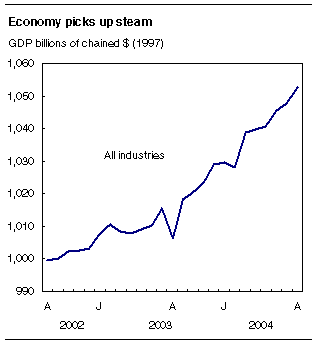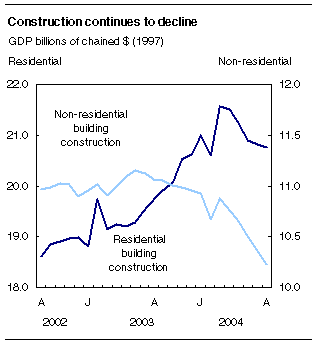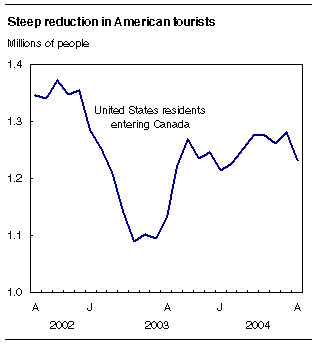
















 |
|
 |                |
Information identified as archived is provided for reference, research or recordkeeping purposes. It is not subject to the Government of Canada Web Standards and has not been altered or updated since it was archived. Please "contact us" to request a format other than those available.

|

Friday, October 29, 2004 Gross Domestic Product by IndustryAugust 2004Canada's gross domestic product (GDP) picked up steam in August, increasing by 0.5% after a 0.2% advance in July. Both the goods and service producing sectors contributed to this strength. Stronger domestic demand, a build-up of manufacturing inventories, and the end of extended planned shutdowns were behind this growth. 
The goods producing sector was pushed by manufacturing and utilities, while the service producing sector was spurred by wholesale and retail trade as well as by the finance, insurance and real estate industries. The main sources of weakness were in construction, forestry and some tourism related industries. Industrial production (the output of Canada's factories, mines and utilities) was up 0.9% in August, marking six consecutive months of expansion. The output of all three sectors was up: factories (+1.0%), mines (+0.4%) and utilities (+1.2%). In the United States, the Index of industrial production edged down 0.2% in August, pulled back by mining and utilities.
Manufacturing sector on a rollOutput of the Canadian manufacturing sector increased 1.0% in August after a 0.4% increase in July. Stronger domestic demand coupled with a build-up of inventories fuelled the increase. Growth was largely concentrated in the fabrication of durable goods: transportation equipment, machinery, and fabricated metal products. Chemicals, beverage and tobacco products were the main sources of growth in non-durable manufacturing. Wood products and the manufacturing of information and communication technology products retreated from a July surge. Both motor vehicle (+3.8%) and motor vehicle parts (+2.1%) production increased after plants reopened following longer than usual shutdowns in July. Output of the railroad rolling stock industry increased 1.9% due to the increased demand for railcars across North America. The production of all types of machinery was up, particularly engines, power turbines and power transmission equipment (+9.1%) and metalwork machinery (+4.9%). Manufacturers of fabricated metal products, such as architectural products and machine shops, continued their brisk pace in August (+1.6%) for a third month in a row. Output of foundries was down because of supply problems. A strike weakened the production of aluminum products. The production of chemicals was up 1.2% due to the increased output of basic chemicals (+2.2%) such as petrochemicals and industrial gases, and of other chemicals (+3.3%) such as printing ink. Brewers (+2.3%) and distillers (+3.9%) increased output while tobacco manufacturers stoked up their production 9.8%. After a strong June and July, wood products manufacturing was down on account of reduced output by sawmills (-1.5%) and millwork (-2.1%). Forestry and logging activity fell by 2.6% in August, as dry conditions in British Columbia prompted logging companies to reduce harvesting operations. Brisk trade for retailers and wholesalersRetailing activity rose 1.1% in August following a 0.4% increase in July. Increased customer traffic was recorded at automotive stores (new motor vehicle dealers, used and recreational motor vehicle and parts dealers, and gasoline stations). Building and outdoor home supplies stores continued to benefit from strong demand for their products. Computer and software stores reported the strongest growth of all retail trade groups. Convenience, specialty food, beer, wine and liquor stores also showed large increases in sales. In August, consumers reduced their spending on clothing and accessories, which may have affected general merchandise stores, including department stores. Wholesaling services rose 0.8% in August on the heels of a 0.9% increase in July. Much of the gain stemmed from a surge in sales of automotive products (vehicles, parts and accessories), and sales of machinery and electronic equipment, due to the robust demand for products such as laptops and cellular phones. The most significant declines in activity were reported by wholesalers of personal and household goods, and by wholesalers of oilseed and grain (where a significant increase in commodity prices occurred). Construction continues to declineConstruction activity declined in August for a fifth month in a row. Residential construction decreased by 0.3%. Housing starts for single residential units were down 5.3%. Housing starts however were up 12% for all types of dwellings, with all of the increase coming from multiple dwelling units. All regions except Quebec saw an increase in housing starts. Housing sales continued to slumber in August, lowering the output of real estate agents and brokers by 0.1%. Non-residential building construction was down 1.2%, its fifth consecutive decline, standing 9.2% below its peak of June 2003. All types of non-residential buildings (industrial, commercial and institutional) registered declines. Engineering, repair and other construction activities declined 0.2%. 
Mining hampered by strikesActivity in the mining sector increased 0.4%, shored up by diamond production, as a strike reduced the output of iron ore by 37%. The production of potash retracted from its July peak by 2.6%. Extraction of oil and gas was reduced by 0.2% as natural gas production returned to its June level. Support activities for mining (mostly drilling and rigging) was up 2.7%, spurred by the higher price for crude oil. The average spot price in US dollars of a barrel of light crude oil increased 9.1% in August from its July average. Decrease in American touristsThe tourism industry was affected by a steep reduction in the number of travellers from the United States, which may have been influenced by concerns about border delays as a result of increased security, and by a stronger Canadian dollar. Travel to Canada from other countries increased slightly in August. As a result, activity in the accommodation industry dropped 2.4%, while the output of motor vehicle rental and leasing was down 1.8%. Air transportation, however, increased 0.2% as most airlines improved their efficiency by carrying more passengers per flight. 
Other sectorsA reduced volume of transactions on the Canadian stock exchanges lowered the activity of stockbrokers, limiting the growth of the finance, insurance and real estate sector to 0.3% in August. Many Canadians watched the XXVIIIth Olympiad in Athens on television, resulting in a 3.1% increase in the output of radio and television broadcasting. Available on CANSIM: tables 379-0017 to 379-0022. Definitions, data sources and methods: survey numbers, including related surveys, 1301 and 1302. The August 2004 issue of Gross Domestic Product by Industry, Vol. 18, no. 8 (15-001-XIE, $12/$118) is now available. A print-on-demand version is available at a different price. Data on gross domestic product by industry for September 2004 will be released on November 30. For general information or to order data, contact Yolande Chantigny (1-800-887-IMAD; imad@statcan.gc.ca). To enquire about the concepts, methods or data quality of this release, contact Bernard Lefrançois (613-951-3622), Industry Measures and Analysis Division.
| |||||||||||||||||||||||||||||||||||||||||||||||||||||||||||||||||||||||||||||||||||||||||||||||||||||||||||||||||||||||||||||||||||||||||||||||||||||||||||||||||||||||||||||||||||||||||||||||||||||||||||||||||||||||||||||||||||||||||||||||||||||||||||||||||||||||||||||||||||||||||||||||||||||||||||||||||||||||||
|
|
|